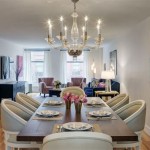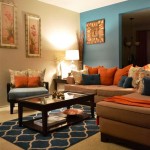Exploring Harmonious House Decor Colour Schemes
Colour schemes play a pivotal role in creating a cohesive and aesthetically pleasing home environment. They dictate the mood, influence the perception of space, and ultimately reflect the homeowner's personality. A well-considered colour scheme can transform a mundane space into a haven of comfort, style, and visual appeal. Understanding the principles of colour theory and how they translate into practical decor choices is essential for achieving a harmonious and impactful result.
The selection of a colour scheme should not be arbitrary. It requires careful consideration of several factors, including the existing architectural features of the house, the amount of natural light available, the intended function of each room, and the personal preferences of the occupants. A successful scheme will integrate these elements to create a balanced and visually stimulating interior.
The principles of colour theory, including understanding the colour wheel, colour relationships, and colour psychology, are fundamental to informed colour scheme selection. Ignoring these principles can lead to a disjointed and unappealing result. Therefore, a foundational understanding of these concepts is crucial for anyone embarking on a home decor project.
Understanding the Basics of Colour Theory
The colour wheel is a visual representation of colours arranged according to their chromatic relationship. It comprises primary, secondary, and tertiary colours. Primary colours (red, yellow, and blue) are the foundational colours that cannot be created by mixing other colours. Secondary colours (green, orange, and violet) are created by mixing two primary colours. Tertiary colours (red-violet, blue-violet, blue-green, yellow-green, yellow-orange, and red-orange) are created by mixing a primary colour with a neighbouring secondary colour.
Colour relationships, or colour harmonies, refer to the ways in which colours interact with each other. Common colour harmonies include monochromatic, analogous, complementary, split-complementary, triadic, and tetradic. Each of these harmonies offers a distinct visual effect and lends itself well to specific design styles. A monochromatic colour scheme utilizes different shades and tints of a single colour, creating a subtle and sophisticated effect. An analogous colour scheme combines colours that are adjacent to each other on the colour wheel, resulting in a harmonious and soothing palette. A complementary colour scheme pairs colours that are opposite each other on the colour wheel, creating a bold and dynamic contrast. A split-complementary scheme uses one colour and the two colours adjacent to its complement, offering a more balanced and less intense contrast than a purely complementary scheme. A triadic colour scheme uses three colours that are equally spaced on the colour wheel, resulting in a vibrant and playful palette. A tetradic colour scheme, also known as a double-complementary scheme, utilizes two pairs of complementary colours, creating a complex and visually rich effect.
Colour psychology explores the emotional and psychological effects of different colours. Warm colours, such as red, orange, and yellow, are associated with energy, excitement, and optimism. Cool colours, such as blue, green, and violet, are associated with calmness, serenity, and tranquility. Neutral colours, such as white, gray, beige, and brown, provide a backdrop that allows other colours to stand out. Understanding these associations helps in selecting colours that align with the intended mood and atmosphere of each room.
Popular Colour Scheme Approaches
Several proven colour scheme approaches can be adapted to suit various preferences and design styles. These approaches provide a framework for creating cohesive and visually appealing interiors.
A neutral scheme uses primarily neutral colours, such as white, beige, gray, and brown, often with subtle variations in tone and texture. This approach creates a calming and sophisticated atmosphere, and it allows for the introduction of pops of colour through accessories and artwork. A neutral scheme is particularly effective in smaller spaces, as it helps to create a sense of openness and airiness.
A warm scheme utilizes warm colours, such as red, orange, and yellow, to create a cozy and inviting atmosphere. This approach is well-suited to living rooms and bedrooms, where comfort and relaxation are paramount. A warm scheme can be particularly effective in spaces that receive little natural light, as it helps to create a sense of warmth and brightness. However, it is important to use warm colours judiciously, as too much intensity can be overwhelming.
A cool scheme utilizes cool colours, such as blue, green, and violet, to create a calming and serene atmosphere. This approach is well-suited to bathrooms and bedrooms, where relaxation and tranquility are desired. A cool scheme can be particularly effective in spaces that receive a lot of natural light, as it helps to create a sense of coolness and refreshment. However, it is important to balance cool colours with warmer tones to prevent the space from feeling sterile or impersonal.
A bold scheme utilizes vibrant and contrasting colours to create a dramatic and energetic atmosphere. This approach is well-suited to spaces where creativity and stimulation are desired, such as home offices and entertainment rooms. A bold scheme can be particularly effective in spaces with strong architectural features, as it helps to highlight and enhance these features. However, it is important to use bold colours carefully, as too much intensity can be overwhelming and visually jarring.
An analogous scheme uses colours that are next to each other on the colour wheel. This approach promotes harmony and creates a serene and cohesive feel. For example, a scheme featuring blues, greens, and teals evokes a sense of nature and tranquility. This is a safe and easy scheme to execute, often resulting in a sophisticated and balanced look.
Practical Considerations for Colour Scheme Selection
Beyond colour theory and popular approaches, several practical considerations influence the ultimate success of a chosen colour scheme. These considerations relate to the physical characteristics of the space and the lifestyle of the occupants.
The amount of natural light in a room significantly impacts how colours are perceived. Rooms with abundant natural light can handle bolder and darker colours without feeling oppressive. Conversely, rooms with limited natural light benefit from lighter and brighter colours, which reflect and amplify the available light. Artificial lighting also plays a crucial role, and it is important to consider the colour temperature of light bulbs when selecting colours. Warm-toned light bulbs can enhance warm colours, while cool-toned light bulbs can enhance cool colours.
The size and shape of a room also influence colour choices. Lighter colours tend to make a space feel larger and more open, while darker colours can make a space feel smaller and more intimate. Vertical stripes can visually elongate a room, while horizontal stripes can make a room feel wider. Colour can also be used to visually correct architectural imperfections. For example, painting a low ceiling a lighter colour than the walls can make it appear higher.
The function of a room should also be considered when selecting colours. Bedrooms and bathrooms, which are intended for relaxation, benefit from calming and soothing colours. Living rooms and dining rooms, which are used for socializing, can handle more vibrant and stimulating colours. Home offices, which require focus and concentration, benefit from neutral and calming colours. The intended use of the space dictates the appropriate colour palette.
Ultimately, the homeowner's personal preferences and lifestyle should be the guiding force in colour scheme selection. The colours should reflect the homeowner's personality and create a space that feels comfortable, welcoming, and representative of their individual style. It is advisable to collect inspiration images, create mood boards, and experiment with sample colours before committing to a final scheme. Testing paint colours in the actual space, under different lighting conditions, is essential for ensuring satisfactory results. A well-chosen colour scheme is not just about aesthetics; it is about creating a home that truly reflects the occupants and enhances their daily lives.

Color Palette For Home 12 Combos Designers Love Havenly Interior Design Blog

Color Palette Interior Ideas Balance Bedroom Bedroomcolors Design Schemes

5 Tips To Help You Choose The Right Colour Scheme Home Decorating Ideas

Color Palette By Paleutr Interior Design Modern Living Room Colors Paint Inspiration

15 Designer Tricks For Picking A Perfect Color Palette

Color Palette For Home 12 Combos Designers Love Havenly Interior Design Blog

Color Palette 3737 Ideas Living Room Colors Blue

Palette For Interior Design Color Ideas

15 Designer Tricks For Picking A Perfect Color Palette

20 Top Interior Color Schemes For Your House Design Foyr Neo
Related Posts







